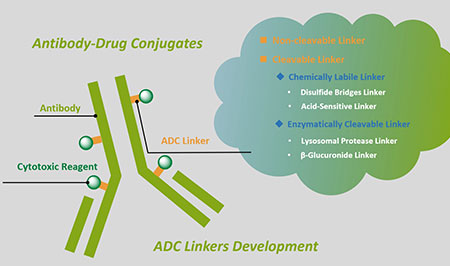1. Targeted Tubulysin B Hydrazide Conjugate for the Treatment of Luteinizing Hormone-Releasing Hormone Receptor-Positive Cancers
Miranda Kaake, Jyoti Roy, Philip S Low, Madduri Srinivasarao Bioconjug Chem . 2018 Jul 18;29(7):2208-2214. doi: 10.1021/acs.bioconjchem.8b00164.
The targeted delivery of chemotherapeutic agents to receptors that are overexpressed on cancer cells has become an attractive strategy to concentrate drugs in cancer cells while avoiding uptake by healthy cells. Luteinizing hormone-releasing hormone receptor (LHRH-R) has attracted considerable interest for this application, since LHRH-R is upregulated in ~86% of prostate cancers, ~80% of endometrial cancers, ~80% of ovarian cancers, and ~50% of breast cancers, but virtually absent from normal tissues. Although LHRH and related peptides have been used to deliver cytotoxic drugs to LHRH-R overexpressing cancer cells, they have suffered from off-target delivery of the therapeutic agents to the liver and kidneys. To reduce such unwanted uptake by peptide scavenger receptors in the liver and kidneys, we have explored the use of a nonpeptidic LHRH-R antagonist (NBI42902) to construct an LHRH-R targeted tubulysin conjugate (BOEPL-L3-TubBH). In vitro studies with BOEPL-L3-TubBH demonstrate that the conjugate can kill LHRH-R expressing triple-negative breast cancer cells (MDA-MB-231 cells) with low nanomolar IC50. Related studies on tumor-bearing mice further reveal that the same conjugate can eradicate MDA-MB-231 solid tumors without any measurable side-effects, yielding mice that gain weight during therapy and show no evidence of tumor recurrence for at least 5 weeks after termination of treatment. That these complete responses are LHRH-R targeted was then established by showing that identical treatment of receptor-negative (SKOV3) tumors yields no antitumor response. Overall, these data provide a proof-of-concept that LHRH-R specific targeting of an extremely toxic drug like tubulysin B can treat LHRH-R positive tumors without causing significant toxicity to healthy cells.
2. Pre-clinical evaluation of EC1456, a folate-tubulysin anti-cancer therapeutic
Paul Kleindl, Ryan Dorton, Christina Dircksen, Iontcho R Vlahov, Melissa Nelson, Alicia Bloomfield, Hari Santhapuram, Christopher P Leamon, Marilynn Vetzel, Joseph A Reddy Sci Rep . 2018 Jun 12;8(1):8943. doi: 10.1038/s41598-018-27320-5.
EC1456 is a folate-tubulysin conjugate constructed with an all-D enantiomeric spacer/linker configuration. When tested against folate receptor (FR)-positive cells, EC1456 demonstrated dose-responsive activity with an approximate 1000-fold level of specificity. Treatment of nude mice bearing FR-positive human xenografts (as large as 800 mm3) with non-toxic doses of EC1456 led to cures in 100% of the mice. Combinations of low dose EC1456 with standard of care agents such as platins, taxanes, topotecan and bevacizumab, safely and significantly augmented the growth inhibitory effects of these commonly used agents. When tested against FR-positive human tumor xenograft models having confirmed resistance to a folate-vinca alkaloid (vintafolide), cisplatin or paclitaxel, EC1456 was found to generate partial to curative responses. Taken together, these studies demonstrate that EC1456 has significant anti-proliferative activity against FR-positive tumors, including models which were anticancer drug resistant, thereby justifying a Phase 1 trial of this agent for the treatment of advanced human cancers.
3. Structural recognition of tubulysin B derivatives by multidrug resistance efflux transporters in human cancer cells
Michal Stark, Yehuda G Assaraf Oncotarget . 2017 Jul 25;8(30):49973-49987. doi: 10.18632/oncotarget.18385.
Multidrug resistance (MDR) is a major hindrance to curative chemotherapy of various human malignancies. Hence, novel chemotherapeutics must be evaluated for their recognition by MDR efflux transporters. Herein we explored the cytotoxic activity of synthetic tubulysin B (Tub-B, EC1009) derivatives (Tub-B-hydrazide/EC0347 and Tub-B bis-ether/EC1820), and their recognition by the MDR efflux transporters P-glycoprotein 1 (P-gp), multidrug resistance-associated protein 1 (MRP1) and breast cancer resistance protein (BCRP). Originally isolated from Myxobacteria, tubulysins exhibited potent cytotoxic activity via microtubule depolymerization, and evaded recognition by these MDR efflux pumps. We show that subtle modifications in the natural Tub-B structure enhance its cytotoxicity and drug efflux efficiency. Whereas increasing the lipophilicity of Tub-B drugs enhanced their diffusion into the cell and consequently decreased the IC50 values (≥ 0.27 nM), increasing drug polarity enhanced their recognition by P-gp (>200-fold resistance in P-gp-overexpressing cells). Furthermore, restricting drug exposure time to the clinically relevant 4 h pulse, markedly enhanced efflux by P-gp, resulting in a 1000-fold increased resistance, which was further enhanced upon increased P-gp levels (i.e. an additional 3-fold increase in P-gp levels resulted in >6,000-fold resistance). The unique ability of EC1009 to evade recognition by MDR efflux pumps warrants drug development of tubulysin B derivatives as potent antitumor agents which overcome MDR in cancer.







